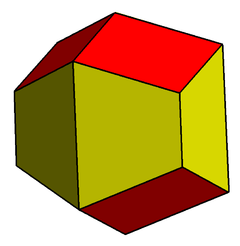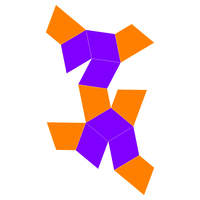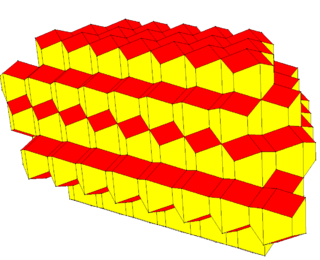Trapezo-rhombic dodecahedron
| Trapezo-rhombic dodecahedron | |
|---|---|
 | |
| Type | Johnson solid dual |
| Faces | 6 rhombus, 6 trapezoid |
| Edges | 24 |
| Vertices | 14 |
| Vertex configuration | (2) 4.4.4 (6) 4.4.4.4 (6) 4.4.4 |
| Symmetry | D3h, [3,2], (*322), order 12 |
| Rotation symmetry | D3, [3,2]+, (322), order 6 |
| Dual polyhedron | Triangular orthobicupola |
| Properties | convex |
| Net |  |
In geometry, the trapezo-rhombic dodecahedron is a convex polyhedron with 6 rhombic and 6 trapezoidal faces. It has D3h symmetry.
Construction
This polyhedron could be constructed by taking a tall uniform hexagonal prism, and making 3 angled cuts on the top and bottom. The trapezoids represent what remains of the original prism sides, and the 6 rhombi a result of the top and bottom cuts.
Space-filling tessellation
A space-filling tessellation, the trapezo-rhombic dodecahedral honeycomb, can be made by translated copies of this cell. Each "layer" is a hexagonal tiling, or a rhombille tiling, and alternate layers are connected by shifting their centers and rotating each polyhedron so the rhombic faces match up.
In the special case that the long sides of the trapezoids equals twice the length of the short sides, the solid now represents the 3D Voronoi cell of a sphere in a Hexagonal Close Packing (HCP), next to Face-Centered-Cubic, an ideal way to stack spheres. It is therefore similar to the rhombic dodecahedron, which can be represented by turning the lower half of the picture at right over an angle of 60 degrees. The rhombic dodecahedron is a Voronoi cell of the other ideal way to stack spheres.
It is the polyhedral dual of the triangular orthobicupola.
See also
- Elongated dodecahedron
- Hexagonal prismatic honeycomb
References
- Williams, Robert (1979). The Geometrical Foundation of Natural Structure: A Source Book of Design. Dover Publications, Inc. p. 170. ISBN 0-486-23729-X.
